The tranquil ambiance of boating across serene waters can be taken to new heights when accompanied by a high-quality marine audio system. However, achieving exceptional audio quality on boats and yachts can be a challenging endeavor due to the unique conditions and demands of the marine environment. From engine noise to vibrations and wind, controlling and enhancing acoustics on the water can be a complex undertaking. But worry not, because with the right approach and sound deadening solutions, you can make your marine vessel a haven of supreme audio performance.
In this guide, we will tackle the challenges of the marine audio landscape and provide insights into how you can create the perfect environment for enjoying your favorite tunes while out on the water. From understanding the crucial factors impacting marine audio performance to selecting the most appropriate sound deadening materials, we've got you covered. We'll also share helpful installation tips and strategies for targeting the most effective areas of your vessel, ensuring you get the most out of your marine audio experience.
So, whether you're embarking on a peaceful fishing trip, hosting a lively yacht party, or merely taking a leisurely cruise along the coast, this guide aims to help you transform your boat or yacht audio system into an immersive, captivating experience. Hop on board, and let's set sail towards sonic excellence in marine audio.
Challenges Impacting Marine Audio Performance
Designing a superior marine audio system requires an understanding of the challenges specific to the marine environment and acoustic performance. Here are a few factors that can impact audio quality on the water:
- Engine and Mechanical Noises: The sound of boat engines, generators, or other mechanical components can create a noisy environment that hampers the listening experience.
- Wind and Wave Distractions: Wind and splashing waves can compete with the music coming from your audio system, necessitating higher volumes to compensate.
- Reverberation and Echoes: The mix of open and enclosed spaces on a boat can cause unwanted reverberation or echo effects, which can muddy the overall audio clarity.
- Vibration and Rattles: Boats contain various components that can vibrate or rattle as they move through the water, creating additional noise interference.
Selecting Marine-Grade Sound Deadening Materials
In order to combat these challenges, it's essential to choose high-quality, marine-grade sound deadening materials that are specifically designed to withstand the unique conditions of the maritime environment. Here are some materials suitable for marine audio sound deadening applications:
- Mass Loaded Vinyl (MLV): MLV is a versatile material known for its excellent noise-blocking characteristics. When applied to bulkheads or engine compartments, it can reduce the intrusion of mechanical and engine noises.
- Closed-Cell Foam: An ideal choice for dampening high-frequency noises and providing thermal insulation, closed-cell foam is lightweight and water-resistant, making it suitable for marine applications.
- Vinyl Decouplers: These materials help isolate vibrations and prevent the transfer of sound energy between surfaces. They are useful for separating speakers from mounting surfaces, reducing structural vibrations.
- Fiberglass or Mineral Wool Insulation: Both options are effective at reducing noise transmission, and when used in combination with other materials, can provide superior acoustic performance in marine environments.
Strategies for Effective Marine Sound Deadening
Maximize the performance of your marine audio system by targeting key areas and following sound deadening installation best practices:
- Insulate the Engine Compartment: The engine is often the loudest component on a boat, and creating a barrier between it and the cabin can significantly reduce intrusive noise levels.
- Soundproof the Bulkheads: Insulating bulkheads with sound deadening materials helps dampen noise from adjacent spaces and improves overall audio quality.
- Isolate Vibrations: Decouple audio components, such as speakers and amplifiers, from their mounting surfaces to minimize vibrations and structural resonance.
- Optimize Speaker Placement: Properly placed speakers help minimize audio distortion and improve clarity. Experiment with placements to find the ideal balance between bass response and overall audio quality.
Tips for Installing Marine Sound Deadening Materials
Keep these helpful tips in mind when installing sound deadening materials on your boat or yacht:
- Clean and Prepare Surfaces: Before applying any sound deadening materials, clean the surface of dirt, oil, or other contaminants to ensure proper adhesion and longevity of the materials.
- Measure and Cut Materials: Measure the surface areas where sound deadening materials will be applied and cut them to size before installation.
- Follow Manufacturer Guidelines: Always consult the manufacturer's instructions when applying and installing sound deadening materials for optimal results.
- Make Adjustments: After installing the materials test the audio system in various conditions, adjusting placement or adding more material if needed.
Conclusion
Achieving outstanding audio quality in the marine environment can be a daunting task. However, by understanding the unique challenges of marine audio performance and employing tailored sound deadening techniques, you can elevate your boat or yacht's audio system to new heights. With sound deading material specially designed for the marine environment and focusing on crucial areas and installation practices, your marine audio experience will be the envy of everyone out on the water.
If you're ready to embark on your journey towards unparalleled marine audio performance, reach out to the experts at B-Quiet for guidance and support. Our team is eager to help you navigate the world of marine sound deadening, ensuring that your boat or yacht becomes a floating oasis of pristine audio bliss.











